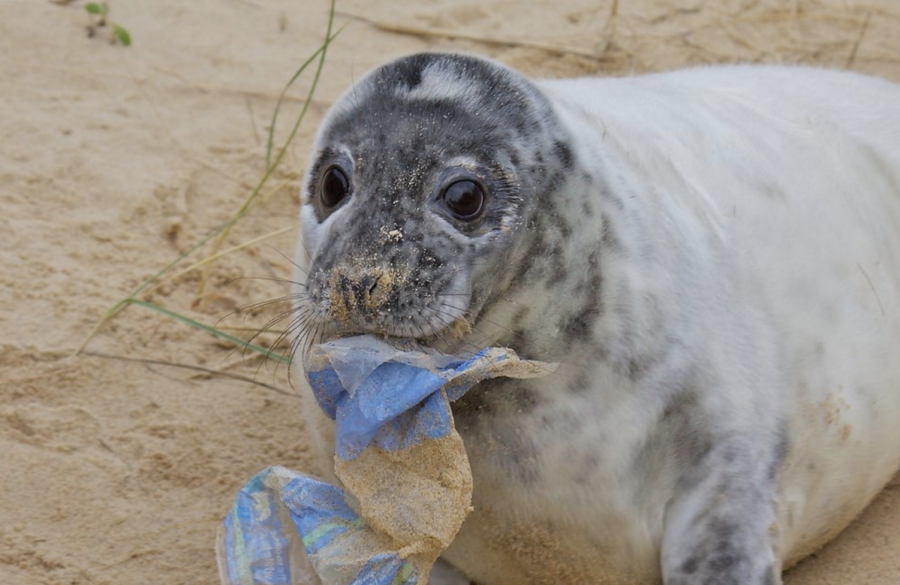Plastic: Earth’s silent virus
January 22, 2019
By Helena Savage
The area of Texas is 268,597 square miles. The Great Pacific Garbage Patch, a heap of plastic organized into a large mass floating in between Hawaii and California is 600,000 square miles.
Over the years, this pile of plastic has progressively grown to a weight of 88,000 tons, and it includes plastic items large and small. It could contain anything from a toothbrush from 10 years ago, to fishing nets, computer monitors, plastic bags and bottles, and plastic home appliances from almost any kitchen (National Geographic).
As of 2012, according to CBC News, a paper cited by the U.S. National Oceanic and Atmospheric Administration says “as many as 100,000 marine mammals could die trash-related deaths each year.” The Great Pacific Garbage Patch stands as only one major issue within the earth-destroying virus known as plastic and at the current rate of plastic production and disposal, our oceans and earth have a dark future ahead of them.
Everyday marine animals that inhabit the oceans and the Pacific region specifically become entangled in plastic bags and fishing nets. This contact with the trash can physically scar and damage many marine animals. Not only are they physically harmed, but since plastics cannot be completely destroyed they are only broken down into microplastics. Here we have yet another reason to avoid plastics at all costs because once they are created, they can never be completely destroyed. Therefore, marine animals consume and ingest microplastics which harms their intestinal system, and many times leads to death.
After hundreds of heartbreaking images, where whales and birds are found on beaches having consumed microplastics and large plastics mistaking them for food, one would think measures would be taken to reduce the presence of plastics in our everyday lives. Alongside these whales and birds, fishing nets and plastic bags entangle themselves around the necks of dolphins, seals, and sea turtles. Honestly, if this isn’t the most vivid reflection of how much humans care for marine wildlife I don’t know what is. The reality of plastics´ impact on marine life and land animals, is just one end of the issue. The effects of plastics on humans will have decades and decades of consequences, that we have not even begun to heed.
It is an undeniable fact that plastic has become a daily necessity in our lives, from the straws in our Starbucks coffee and our toothbrush used every morning and night, to the tiny plastic covering around the tips of our shoelaces and our school supplies. Even our high school students’ much-loved Chromebooks are fancied with an exterior of plastic. (Although things are looking up in 2019, as bamboo toothbrushes, metal and paper straws, biodegradable phone cases, reusable snack and sandwich bags, and many more items have become popular.)
All I needed to do, in order, to realize the severity of our plastic problem was see one photo of a whale and a sea turtle killed in the hands of mankind. Although the worst part about their deaths is that the plastic is a silent killer that creeps its way into our oceans day by day. According to a 2015 study, “The United States contributes as much as 242 million pounds of plastic trash to the ocean every year” (USA Today).
In a perfect world, we would all recycle; no one would litter; all plastic would biodegrade, and we would respect the environment. But we don’t. This does not mean that people are not aware of the problem, but people have other activities to do rather than spend their day sifting through recycling and making their lives 100 percent plastic free. That is the worst part in all of this: There is no time in people’s busy lives to worry about one more thing. It is the scientists and the government’s job to fix all of our environmental problems, right?
But needless to say, we have made progress towards more eco-friendly and plastic-free lives, and corporations have also significantly reduced their reliance on plastics. This all comes despite the backwardness of some of our government’s views on the environment.
In the end, all we can do is limit the presence of plastic in our lives, and thank the organizations working to clean our oceans and beaches. Sadly, as much of the solutions for our current environmental crisis go, all we can do is reduce the effects of plastic waste. One of the first places we can begin is bringing down the 91 percent amount of plastic that is not recycled to start lessening our human impact on Earth.
We are the only living things that can tackle the virus of plastic that we began over 100 hundred years ago, and we should strike quickly before Earth plunges further into the abyss of plastic waste.
60 Minutes Video on the tragic reality of plastic:
Links to reduce your plastic footprint:
https://www.amazon.com/Bamboo-Toothbrush-Adults-8-Pack-Biodegradable/dp/B07CNPVG3N
https://pelacase.com/ (I have a pela case, and it is great!)
https://www.amazon.com/Hiware-200-Pack-Biodegradable-Paper-Straws/dp/B07D7L5Z85
http://nymag.com/strategist/article/best-metal-straws-review.html
Sources:
https://www.nationalgeographic.org/encyclopedia/great-pacific-garbage-patch/
https://www.usatoday.com/story/tech/science/2018/03/22/great-pacific-garbage-patch-grows/446405002/
https://www.cbc.ca/news/technology/great-pacific-garbage-patch-affecting-sea-life-1.1220673
https://conserveturtles.org/information-sea-turtles-threats-marine-debris/




